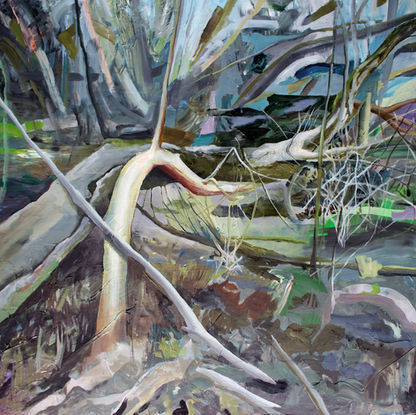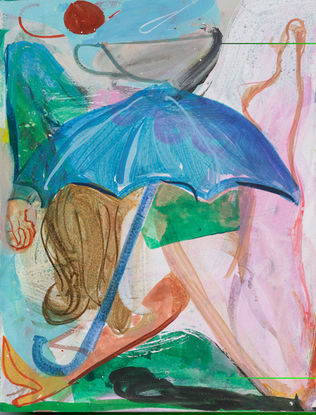
The theme for this edition of our Home-Works series grew out of a conversation that the collective had at one of our on-line monthly meetings for Rosalux. It began as a lamentation of not having informal and regular in person connections with other artists and how it was affecting each others studio practices and then evolved into a discussion about the artists we had known that had the biggest impact on our careers.
One of the most valuable aspects of being a member of the Rosalux collective is the network of artists that our members have the opportunity to work with and the lasting relationships that have formed over the time we have spent with one another. Reflecting on these relationships and the importance of having reliable counsel and inspiration in the form of a like minded peer group, we decided to each invite one other artists who has had an impact in some way on our own careers and creativity to be a part of this edition. Each artist has paired a piece of their own work alongside their guest and offered a little insight into their personal relationship in addition to the visual. While we are unable to be amongst our friends at the moment, we take some comfort in being able to co-mingle in these pages while we work towards connecting in new spaces and places once again.
Connections
Priscilla Briggs / Hannah Calkins
Connections are necessary for developing communities of all kinds. I joined Rosalux Gallery to connect with a community of artists in the Twin Cities. As a professor at Gustavus Adolphus College, I have made long-lasting connections with students as they graduate and become peers, sometimes collaborating on projects. This past summer 2020, Hannah Calkins and I worked in parallel to explore issues of gesture as gender performance. These two works, although completely different in method and vision, came out of research and conversations about what it means to perform gender and to exist in your own skin as a woman.


Betsy Byers / Emily Sheehan
I met Emily in our graduate school program at MCAD back in 2006. Her studio practice and work spoke to my own curiosities about how we interact, know and make connections between our bodies, space and place.Emily actively creates internal and external influences that serve to heighten her translation of sensory elements. There’s Just No Telling offers a layered perspective where time and movement are recalled through the blurred boundaries of the folded paper form. The experience of the triptych extends the time-based understanding of the work as the eye moves between these captured moments and indicated movement of the form expanding and contracting. In her artist statement, Emily explains, “The activity of perceptual drawing holds me in that human space longer. In my effort to portray a moment in a drawn image, I consider the situation of the encounter and the depth of the physical and psychological responses triggered in the moment; situational elements like time, pace, movement, space, pressure, light, and darkness trigger feelings of anticipation, urgency, frustration, pain, anxiety, fear, annoyance, joy, vulnerability, frenzy, hope and despair.”


Melissa Borman / Megan Marsh Pine
Both Melissa Borman’s and Meagan Marsh Pine’s works integrate the figure in the landscape. The relationship between individuals and their experience of their surroundings is grounded in their individual physicality. Several years ago, Borman sustained an injury that instigated her interest in depictions of the body. Wading through historical and contemporary works depicting passive female figures she set out to make images that engage conventional aesthetic associations between women and nature. With members of her community, including fellow artists and former roller derby teammates as subjects, Borman began making photographs of women and gender non-conforming people engaging with the natural world.
Re-imagining the natural world through a queer utopic lens, Meagan Marsh Pine’s ongoing project Stargazing focuses on world-building through portraiture. Inspired by the environmental, political, and utopic themes within the genre of science fiction, Marsh Pine invites the viewer to imagine an equitable place that engages the body and the land. In an era in which many people are excluded from engaging with the landscape the work depicts a future in which land and bodies are united.


Mary Gibney / Carolyn Swiscz
My Connections painting is of a two-headed lady, how much more connected could that be? It touches on the sideshows of the past where audiences could enjoy a guilty thrill gawking at freaks both real and contrived. Also it’s about which of our faces we decide to show to the world, with our human mess of two or more-sided thoughts, feelings, indecision, & second-guesses. Carolyn Swiszcz makes paintings using printmaking and collage. Also zines! They are fresh and funny, graphically exciting, full of tiny flourishes and surprises. She is deeply connected to her St. Paul neighborhood and this image of Granny’s Donuts is part of that landscape. She opens our eyes to the beauty in the somewhat scruffy, semi-suburban street scene of buildings and businesses that are often unloved and overlooked. Although people rarely appear in her art (except her zines, which are full of humans), their presence is there - these are not abandoned places but used by regular people going about the business of life - having a drink, eating pizza, enjoying a donut now and then, getting by in the world.


Shannon Estlund / Jonathan Lux
I met Jonathan Lux in the early aughts when we were both living in Jacksonville, Florida, and for a little while we shared a studio building. Because we both grew up in Jacksonville and know so many of the same people it feels like we’ve known each other forever. I have always been inspired by Jon’s paintings. His work has changed over time; he’s lived in New York and London and his new paintings reflect those experiences. One constant is that his work has always felt adventurous and exciting. His paintings are like a party you’d want to go to, full of clever and possibly (probably) dangerous characters.


Frank Meuschke / Henry P. Raleigh
I enrolled in Hank’s intermediate painting course. Hank prodded me to leave the art education major. Said I reminded him of himself as a young man. Said painters can do anything. Everyone came to Hank’s critiques, even the sculptors. Hank once said my painting went all the way back to Rembrandt. Disabused me of the idea there could be success in art. Ribbed me for having good grades. Hank said never paint landscape if you want any kind of career. Said people don’t buy green paintings. Said curators will never travel to Brooklyn. Hank retired to Greenport, Long Island. Hank and I exchanged letters. Said I was getting pretty good. Hank and I traded a small landscape study with each other. Took me to see an elderly, real painter on Shelter Island. Didn’t paint much anymore but loved to watch B&W films. Hank wrote I was a glorified secretary in his last letter to me. Hank died in 2017. His daughter said there was no funeral, memorial, or obituary.


Terrence Payne / John Diebel
I have been a John Diebel fan for going on twenty years now. When I first encountered his cut paper and inked collages assembled with antique paper and imagery, I was drawn to the graphic sensibility of his work and the warmth created by his thoughtful use of the medium. I have several pieces of John’s in my own collection and they are some of my favorites by far, never failing to amuse, inspire and reward me for my attention. I have enjoyed collaborating with John on projects and exhibitions over the years and have been lucky enough to have formed a friendship in that time built on a mutual respect and admiration for one another's work.


Rebecca Krinke / Hattie Smith Lindsley
I learned about Hattie’s work in painting and landscape architecture by finding it online, and reached out to her because I am also an art-landscape architecture person. Hattie is currently doing a residency at Building 98 in Marfa, Texas while completing a masters in landscape architecture at Harvard. As a painter, Lindsley creates large abstract oil pieces, but she is experimenting with her plein air watercolors, a little portraiture, and using some painting in her drawings this semester. The new collage she shared for this show is about labor and the picturesque.
Click on Image for an expanded view with image description and artist's comments